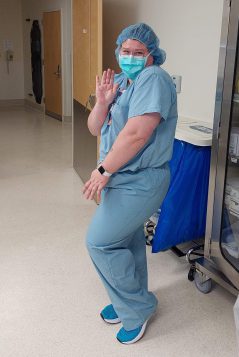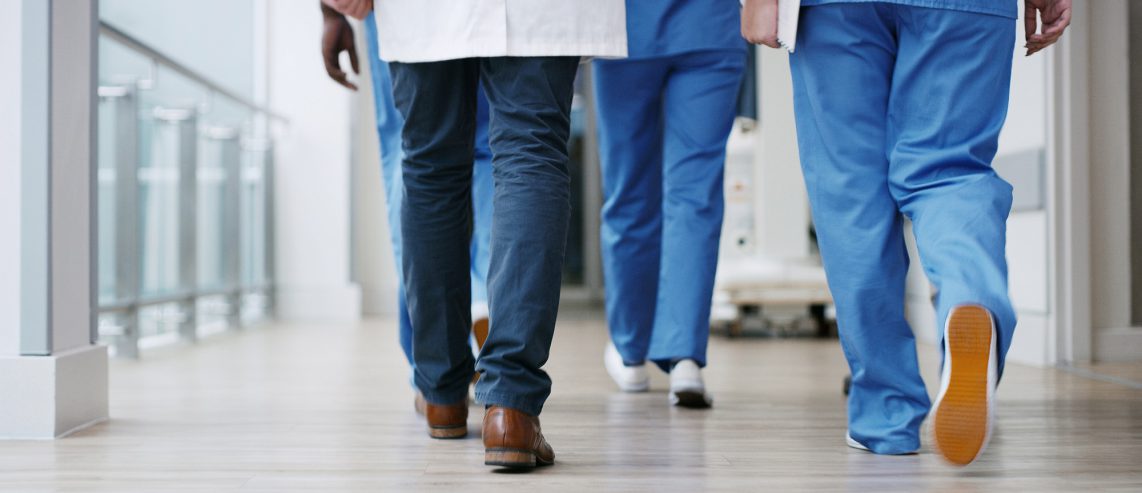 As a dedicated UPMC Lititz operating room nurse, Lindsey Roth is always on her feet.
As a dedicated UPMC Lititz operating room nurse, Lindsey Roth is always on her feet.
So when she first experienced lower back and groin pain in early February, she initially dismissed it as a pulled muscle or job-related body aches.
For a week, the pain intensified and her leg started to swell.
“As the week went on, it got more swollen and painful,” she says. “Nurses are very bad patients, so I just kind of brushed it off and thought it would go away.”
Lindsey’s swelling and pain persisted, and she finally sought medical help. An initial ultrasound revealed no blood clots but did show abnormal blood flow from her leg into her pelvis.
She took to Google, and the results suggested May-Thurner syndrome, a vascular condition affecting a vein in the pelvis.
“I jokingly posted on Facebook, and a couple of people I knew said they had that,” she says. “I realized it wasn’t all that uncommon. So, I advocated for further testing, but they were going to have me wait two weeks to get that testing done.”
After more than a week of working through the pain, she finally told her UPMC co-workers about her symptoms. A doctor at the hospital urged her to head to the emergency department immediately for additional testing.
There, specialists told her she had a deep vein thrombosis, a blood clot located deep in her leg. She also had a pulmonary embolism, which is a blood clot that restricts blood flow to an artery in the lung.
She needed emergency — and potentially lifesaving — vascular surgery.
A colleague recommended Brian Cronin, DO, a vascular surgeon at UPMC Lititz.
Never Miss a Beat!
Subscribe to Our HealthBeat Newsletter!
Thank you for subscribing!
You can now select the specific newsletters you'd like to receive.
You are already subscribed.
Subscribe to more newsletters in our email preference center.
Sorry, an error occurred. Please try again later.
Get Healthy Tips Sent to Your Phone!
Lindsey’s Journey to Vascular Surgery
Lindsey says she feels “blessed” by that recommendation.
During and after her thrombectomy, a surgical procedure to remove the blood clot, Lindsey says Dr. Cronin’s bedside manner, professionalism, and compassionate communication style afforded her the “best possible experience and outcome I could’ve asked for.”
“The surgery and the recovery were nothing like I thought they were going to be. He really advocated for me to get this done as soon as possible, especially because I am a nurse and he knows I’m on my feet all day. The faster you get this fixed, there’s less likelihood that you’ll have extensive swelling afterward, and some people have swelling for life after this, so the fact that he made the procedure happen so quickly greatly improved my quality of life and my livelihood, given that I’m a nurse.”
“If I waited any longer, I could have swelling issues, the clot could have migrated, and I literally could have died,” Lindsey adds. “He facilitated all of this and made it so easy and not stressful.”
Her recovery was swift, she says, with the surgery’s dime-length incision on the back of her leg healing surprisingly fast. She had little to no bruising and almost no pain during recovery, she says. Because of her pulmonary embolism, she had some shortness of breath, but “as far as the procedure itself, I probably could have gone back to work immediately if that was all I had wrong with me.”
“The incision was so minuscule and healed amazingly,” she says. “Rest was really important in my recovery, and now I don’t struggle with swelling in my leg. I’m up and down at work all the time and I’m not doing anything different except taking some medication and wearing compression socks. I feel like I did before I had the blood clot. I feel normal.”
Not only did Dr. Cronin regularly check in with Lindsey about how she was feeling, but he also took time to get to know her parents during her brief time in the hospital.
“He knew them by name by the time we were done, and I was only in the hospital for two days,” she says. “He always answered all of their questions and made sure he talked to them in person after my surgery.”
Her experience with Dr. Cronin inspired her to continue to go above and beyond for patients in her own career.
“I love to help people and I’ve always wanted that, but it makes you feel very blessed and want to go the extra mile for patients even more than I had before,” she says. “I really felt like I didn’t have to worry about anything and that everything was taken care of.”
As many as 900,000 American adults develop a deep vein thrombosis or pulmonary embolism each year, according to the Centers for Disease Control and Prevention. Roughly one-third to one-half of those who develop a deep vein thrombosis will have long-term complications such as swelling, pain, or discoloration. It’s vital to seek treatment right away to prevent serious complications.
Some symptoms associated with deep vein thrombosis include swelling, pain or tenderness in the leg, arm, and/or groin area, red or discolored skin, larger-than-normal veins near the skin, and more.
For those experiencing similar symptoms, Lindsey’s advice is to see a doctor or visit an emergency room as soon as possible.
“If you know something isn’t right, go to the ED,” she says. “If I had just gone to the ED at the beginning, maybe everything would have moved a little bit faster for me and I wouldn’t have been in pain for a week. Don’t be silly like me and not want to burden anyone. Even if it’s just a pulled muscle, don’t ignore it. Just go get it checked out.”
UPMC offers experienced vascular surgeons and leading-edge technology to provide patients with access to the most advanced, minimally invasive treatment options that reduce recovery time, blood loss, pain, and complications.
To learn more about vascular services available near you, visit our website.
About Heart and Vascular Institute
The UPMC Heart and Vascular Institute has long been a leader in cardiovascular care, with a rich history in clinical research and innovation. As one of the first heart transplant centers in the country and as the developer of one of the first heart-assist devices, UPMC has contributed to advancing the field of cardiovascular medicine. We strive to provide the most advanced, cutting-edge care for our patients, treating both common and complex conditions. We also offer services that seek to improve the health of our communities, including heart screenings, free clinics, and heart health education. Find an expert near you.
